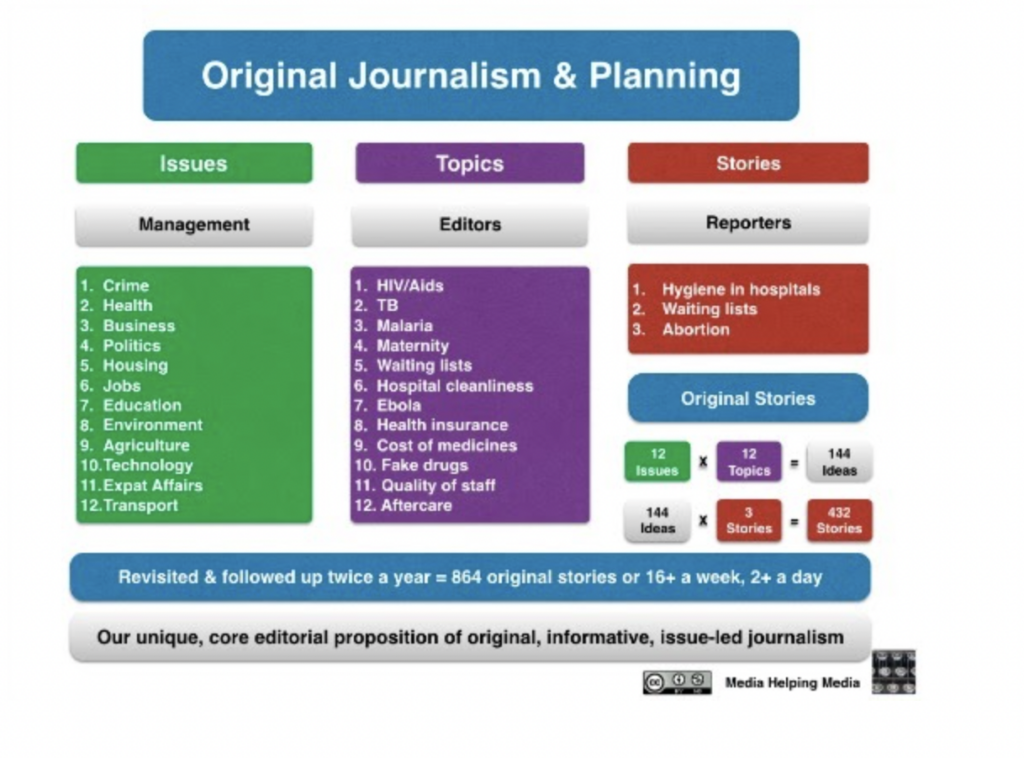
A media business is like a table with four legs – the target audience, the editorial proposition, values, and the market. Each leg has to be strong and firm. If one leg is weak, the table wobbles.
1: Target audience
First you need to know the profile and needs of your target audience. You can do this by hiring an expensive market research team, or you can use informed guesswork.
My preference is the latter. In my experience this works well, and the exercise can be carried out in less than a day.
Gather your senior team from editorial, sales, marketing, and business development.
Obtain some existing market data; it’s likely that the local audience segments have already been identified. If not, it’s not difficult to work this out.
Audience segments are groups of similar people with overlapping interests.
Advertisers use a tool called ‘audience segmentation’ in order to identify existing and potential customers. They then ‘target’ that group in order to sell their products.
They gather information about segments of society based on likes, dislikes, lifestyle, current product usage, interests, aspirations, and media habits.
A smart media organisation needs to do the same. It needs to know who it is creating content for and understand the interests and concerns of that audience.
Advertisers use segmentation to ‘superserve’ several audience groups in order to focus effort to achieve maximum return.
Journalists can adapt this strategy to ‘superserve’ clearly defined target audience groups whose information needs reflect those of the whole audience. Consider the diagram below.

Focus on three audience segments and super-serve them. Try to imagine one character that best represents each group.
Download pictures from the internet of people who fit the character profiles you have identified.
Ask the following questions:
- What are their interests and what stories would they read?
- What are their concerns? You need to find the answers they require.
- What would turn them off? Identify the stories they would probably skip.
- What is their lifestyle, are they married, in a relationship, single, have they got children?
Are you catering for their personal and lifestyle interests? - What do they buy and what are they unlikely to buy? Make sure you have the right adverts in your output.
Once you have these profiles, share them with your journalists so they know who they are writing for.
Do the same with the sales and marketing team so they know what adverts the audience would be interested in.
When this exercise has been completed, print these three character profiles and stick them on the newsroom and the sales department walls.
Make sure that every story is written for these audience groups and uses the language that they understand. Advertising on your site should reflect your users’ interests and aspirations.
Central to all this is carrying out an exercise to identify the issues, themes and stories your news organisation covers that address the concerns and interests of your audience and, in turn, help inform the public debate.
Think of it like peeling an orange. Inside you’ll find nine segments. Each segment represents an audience group.
One segment might be farmers, another youth, and a third businessmen and women.
If you examine the information needs of each group you will find that there will be considerable overlap at the centre. This is your unique editorial proposition.
See our training module ‘Identifying the target audience and its information needs’.
2: Unique editorial proposition
The overlap in the segments shown above will give you an idea of the issues that affect the majority of the audience.
Covering these issues will set you apart from the competition. It tells the audience that your media organisation is where they will find the news and information that is most relevant to their lives.
You do this by planning editorial coverage that addresses those issues. This is about producing original pro-active in-depth journalism that digs deep and asks searching questions.
Gather your team and list the issues that impact the lives of your three main target audience groups.
- Try to find at least 10 issues.
- Then try to find at least 10 topics on each issue
- Finally try to find three original stories to illustrate each topic.
By the end of the exercise you will have 300 original stories. Revisit those stories twice a year and you have 600 stories, which is almost a dozen exclusive stories a week.
These stories are managed by your forward planning editor.
The graphic below shows this exercise carried out when working with a media house in Africa.

See our training modules ‘Establishing a market differential with original journalism’ and ‘Strategic forward planning for media organisations’.
This will create your issue-led journalism strategy that will deliver a wealth of original stories, planned in advance to save resources, and which will give you a news lead and a clear market differential.
This will become your core editorial proposition (CEP). Every news organisation must have one.
It defines what you offer that nobody else offers, or the way you research and present material that is different from what your competitors are offering.
This is your market differential designed to win over the audience groups you are targeting.
And if you think you already have one, think again; changing audience behaviour demands a regular review of what you offer. A CEP that is more than a year old is a museum piece.
Your CEP sets out what your news organisation offers. It is about what you say that nobody else says. It helps clarify the standards of presentation and subject matter the users can expect you to produce.
In marketing terms, it can be an important process in defining your news brand. In terms of your online and mobile services, defining your CEP also helps you decide what to include and what to leave out.
It helps journalists decide how to ensure the online version of your output is focused.
It will offer your audience clarity and comfort as they begin to get to know how to access and use your news on the various devices on which you are delivering your content.
Linked with a multi-platform authoring strategy generated from a converged newsroom, it will also offer a consistency of editorial message across all outlets.
3: The market
Once you know your target audience and have defined your CEP, you can start to plan your revenue-generation strategy.
As stated before, the sales and marketing team and the business development team should be part of the process of defining the target audience.
If they are not, they will have a difficult job monetising the content.
If they are involved they will have a head start in thinking through their sales and marketing campaigns.
Once you have circulated the profiles of the characters you are going to super-serve, sales and marketing can get on with the job of building campaigns around those characters.
4: Values
Your audience will return if your content …
- is compelling, well produced, original and distinctive.
- addresses the issues that concern them most.
- is easy to understand and accessible on multiple devices.
- can be trusted – the integrity of your news organisation is essential.
The ethics that underpin your editorial and business decisions need to be visible in all you do.
It is important to set out a code of ethics and ensure that all those who work for you, whether in the newsroom or out in the market, abide by those rules and apply them to all their dealings with the public, clients, stakeholders and suppliers.
You might want to publish your promise to the audience, including your code of ethics, in an “about us” page on your site.
Summing up
This text explains how to build a strong media business by focusing on four key elements, visualised as the legs of a table:
- Target audience: Those who turn to your for their news
- Understanding your audience is crucial. Instead of expensive market research, use a team workshop to create detailed profiles of your ideal readers/viewers.
- Identify three main audience segments (groups of people with similar interests).
- Create a representative “character” for each segment, complete with a picture and details about their interests, concerns, lifestyle, and buying habits.
- Use this information to tailor your content and advertising to each segment.
- Think of it like an orange, with each segment being a section of the orange. The overlapping centre is the core audience.
- Unique editorial proposition: What makes you different
- Determine the core issues that matter to your target audience.
- Develop original, in-depth journalism that addresses these issues.
- Create a list of issues, topics, and stories to cover, ensuring a consistent flow of unique content.
- Your unique editorial proposition (CEP) is what sets you apart from competitors. It’s your special angle or approach.
- Regularly review and update your CEP to stay relevant.
- The Market: How you make money
- Involve your sales, marketing, and business development teams in the audience and editorial planning process.
- Use the audience profiles to create targeted advertising and marketing campaigns.
- Essentially, knowing your audience allows you to sell to them, and sell advertising that is relevant to them.
- Your values: What you stand for
- Build trust by providing high-quality, relevant, and accessible content.
- Establish a clear code of ethics and ensure everyone in your organisation follows it.
- Be transparent about your values and promises to your audience.
- Integrity is paramount.
In simple terms:
- Know your audience.
- Create unique and valuable content.
- Generate revenue by understanding your audience and market.
- Maintain high ethical standards.
If any of these “legs” are weak, the media business will be unstable.








